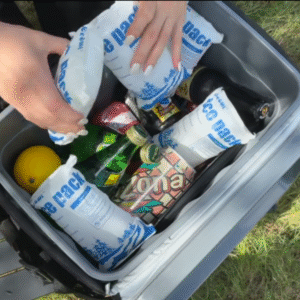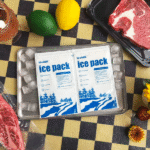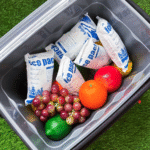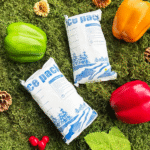أكياس شحن الثلج الجاف & حزم الثلج الجاف: الحلول النهائية لسلسلة التبريد
عند شحن البضائع الحساسة لدرجة الحرارة مثل المواد الغذائية, الأدوية, أو عينات التكنولوجيا الحيوية, ضمان الظروف المناسبة أمر بالغ الأهمية. أكياس شحن الثلج الجاف وأكياس الثلج الجاف تم تصميمها للحفاظ على درجات حرارة منخفضة للغاية أثناء النقل, منع التلف وضمان وصول منتجاتك بأمان. تستكشف هذه المقالة فوائد استخدام هذه المنتجات, كيف تعمل, وأفضل الممارسات لضمان شحنات آمنة وفعالة.
-
كيف تعمل أكياس وعبوات شحن الثلج الجاف للشحنات الحساسة لدرجة الحرارة?
-
ما هي المزايا التي توفرها أكياس وعبوات الثلج الجاف مقارنة بطرق التبريد التقليدية؟?
-
كيف يمكن للشركات تحسين لوجستيات سلسلة التبريد الخاصة بها باستخدام الثلج الجاف?
-
ما هي الاحتياطات التي ينبغي اتخاذها عند استخدام الثلج الجاف للشحن?
كيف تعمل أكياس وعبوات شحن الثلج الجاف للشحنات الحساسة لدرجة الحرارة?
أكياس شحن الثلج الجاف وأكياس الثلج الجاف ضرورية للحفاظ على درجة الحرارة الصحيحة أثناء نقل البضائع القابلة للتلف. كلاهما يستخدم ثاني أكسيد الكربون الصلب (الثلج الجاف), والذي يتصاعد مباشرة من الحالة الصلبة إلى الحالة الغازية عند -78.5 درجة مئوية (-109.3° f). يعد هذا البرد القارس مثاليًا للحفاظ على المنتجات الحساسة مجمدة دون فوضى بقايا الماء الذائبة التي تحصل عليها من الثلج التقليدي.
العلم وراء الثلج الجاف
-
عملية التسامي: يتصاعد الثلج الجاف مباشرة إلى الغاز, دون ترك أي بقايا ماء, مما يزيل خطر إتلاف البضائع الحساسة بسبب ذوبان الجليد.
-
العزل الحراري: هذه الحقائب والعبوات مصنوعة من مواد تقلل من انتقال الحرارة, ضمان أن يستمر الثلج الجاف لفترة أطول دون التسامي المبكر.
| نوع المنتج | حالة الاستخدام المثالية | نطاق التحكم في درجة الحرارة |
|---|---|---|
| أكياس شحن الثلج الجاف | الشحنات السائبة أو الكبيرة | -78.5درجة مئوية (-109.3° f) |
| حزم الثلج الجاف | دقيق, شحنات أصغر | -78.5درجة مئوية (-109.3° f) |
فوائد استخدام الثلج الجاف لشحن البضائع القابلة للتلف
شحن المواد القابلة للتلف مثل المأكولات البحرية, لحمة, أو الأدوية تتطلب حلول تبريد فعالة. الجليد الجاف يوفر درجات الحرارة المنخفضة اللازمة للحفاظ على نضارة وفعالية هذه العناصر أثناء النقل.
المزايا الرئيسية للثلج الجاف للشحن:
-
درجات حرارة شديدة البرودة: يضمن الثلج الجاف بقاء المنتجات مجمدة, حتى لفترات العبور الطويلة.
-
لا بقايا الماء: على عكس الجليد العادي, الثلج الجاف لا يذوب, منع أي ضرر للمياه على العناصر الحساسة للرطوبة.
-
فعالة من حيث التكلفة: على الرغم من أن الثلج الجاف قد يبدو في البداية أكثر تكلفة, غالبًا ما يكون سعره أقل من الثلج التقليدي لأنه يقلل من التلف والهدر بمرور الوقت.
التطبيقات العملية للثلج الجاف في الصناعات المختلفة:
-
صناعة الأغذية: تعتمد شركات المأكولات البحرية على الثلج الجاف للحفاظ على المأكولات البحرية طازجة أثناء الشحن لمسافات طويلة, التقليل من التلف والحفاظ على الجودة.
-
الأدوية: تستخدم شركات الأدوية الثلج الجاف لحفظ اللقاحات, الأدوية, والبيولوجية ضمن درجات الحرارة المطلوبة أثناء الشحن.
-
التكنولوجيا الحيوية & بحث: تستخدم شركات التكنولوجيا الحيوية الثلج الجاف للحفاظ على العينات الحساسة لدرجة الحرارة أثناء البحث والنقل.
مثال واقعي: قامت إحدى شركات الأدوية بتخفيض أضرار الشحن المرتبطة بدرجات الحرارة بنسبة 30% عن طريق التحول إلى الثلج الجاف, ضمان وصول لقاحاتها ضمن نطاق درجات الحرارة المطلوبة دون أي تنازلات.
كيف يمكن للشركات تحسين الخدمات اللوجستية لسلسلة التبريد باستخدام أكياس وحزم شحن الثلج الجاف?
التكامل أكياس شحن الثلج الجاف وحزم الثلج الجاف في العمليات اللوجستية الخاصة بك يمكن تبسيط العمليات, خفض تكاليف الشحن, وتحسين الجودة الشاملة للخدمة. فيما يلي بعض الطرق التي يمكن للشركات من خلالها تحسين لوجستيات سلسلة التبريد الخاصة بها باستخدام حلول التبريد هذه.
تحسين لوجستيات سلسلة التبريد باستخدام الثلج الجاف:
-
تحسين التعبئة: استخدم حاويات الشحن المعزولة جنبًا إلى جنب مع عبوات الثلج الجاف لفترات عبور أطول. وهذا يضمن بقاء درجة الحرارة ثابتة طوال الرحلة.
-
التعامل الفعال: يعد التدريب المناسب لموظفي الخدمات اللوجستية على التعامل الآمن مع الثلج الجاف أمرًا ضروريًا لتجنب الحوادث وضمان بقاء المنتجات في درجة الحرارة الصحيحة.
-
مراقبة درجة الحرارة: استخدم أنظمة مراقبة درجة الحرارة في الوقت الفعلي لتتبع أداء الثلج الجاف طوال عملية الشحن. وهذا يساعد في منع التلف وضمان جودة المنتج.
ما الذي يجب عليك مراعاته عند استخدام الثلج الجاف للشحن؟?
بينما يعتبر الثلج الجاف حل تبريد فعال, هناك العديد من العوامل التي يجب على الشركات مراعاتها لضمان الاستخدام الآمن والسليم.
الاعتبارات الأساسية للتعامل الآمن والشحن:
-
تهوية: يتصاعد الثلج الجاف إلى ثاني أكسيد الكربون, والتي يمكن أن تشكل خطر الاختناق في الأماكن الضيقة. التأكد من التهوية الكافية في جميع المناطق التي يستخدم فيها الثلج الجاف.
-
تخزين: يجب تخزين الثلج الجاف في حاويات معزولة لإبطاء التسامي. يجب أن تبقى بعيدا عن أشعة الشمس المباشرة والحرارة لمنع التسامي بشكل أسرع.
-
وضع العلامات واللوائح: يتم تصنيف الثلج الجاف على أنه مادة خطرة ويتطلب تعليمات محددة لوضع العلامات والتعامل معها. يجب أن تلتزم الطرود التي تحتوي على الثلج الجاف باللوائح التي وضعتها DOT وIATA.
| اعتبار | وصف | أفضل الممارسات |
|---|---|---|
| تهوية | قد يكون تراكم ثاني أكسيد الكربون خطيرًا في الأماكن الضيقة | استخدمه دائمًا في المناطق جيدة التهوية |
| تخزين | يزيد معدل التسامي في الظروف الدافئة | تخزين في بارد, حاويات معزولة |
| أنظمة | يصنف الثلج الجاف على أنه مادة خطرة | ضمان وضع العلامات والامتثال المناسبين |
2025 الاتجاهات في شحن الثلج الجاف للسلع الحساسة لدرجة الحرارة
مع استمرار الشركات في إعطاء الأولوية للسلع الطازجة والقابلة للتلف, يظل الثلج الجاف جزءًا لا غنى عنه في العملية اللوجستية لسلسلة التبريد. فيما يلي نظرة على أحدث الاتجاهات في شحن الثلج الجاف مع اقترابنا 2025.
الاتجاهات الناشئة في مجال لوجستيات الثلج الجاف:
-
ارتفاع الطلب على الأطعمة الطازجة: مع تزايد تفضيل الطازج, الأطعمة العضوية, تتجه الشركات بشكل متزايد إلى الثلج الجاف لضمان عمليات التسليم السريعة والآمنة.
-
الاستدامة: تستكشف الشركات حلولاً صديقة للبيئة لمصادر الثلج الجاف وتعبئته لتلبية احتياجات المستهلكين المهتمين بالبيئة.
-
تقنيات التغليف الذكية: يتيح دمج أجهزة الاستشعار وأجهزة إنترنت الأشياء في أكياس شحن الثلج الجاف إمكانية المراقبة في الوقت الفعلي, تحسين الكفاءة وتقليل التلف.
نظرة السوق: من المتوقع أن يستمر سوق شحن الثلج الجاف العالمي في النمو, مع قطاعات مثل الأغذية والأدوية التي تقود الطلب. ومن المتوقع أن يؤدي التغليف الذكي والحلول الصديقة للبيئة إلى دفع المزيد من الابتكارات في الصناعة.
التعليمات
س 1: ما هي مدة بقاء الثلج الجاف في كيس أو عبوة شحن؟?
عادة ما يستمر الجليد الجاف بين 18-24 ساعات, اعتمادا على عوامل مثل الكمية المستخدمة, العزل, ودرجة الحرارة المحيطة.
Q2: هل يمكنني استخدام الثلج الجاف للشحن دون أي تدريب خاص؟?
من الضروري اتباع إرشادات السلامة عند التعامل مع الثلج الجاف. التهوية والتخزين المناسبين ضروريان للنقل الآمن. يوصى بالتدريب على التعامل مع الثلج الجاف.
خاتمة
أكياس شحن الثلج الجاف وأكياس الثلج الجاف هي أدوات أساسية للشركات التي تحتاج إلى الحفاظ على التحكم الصارم في درجة الحرارة أثناء عملية الشحن. سواء كنت تقوم بشحن الأطعمة القابلة للتلف, الأدوية, أو عينات التكنولوجيا الحيوية, تضمن هذه المنتجات بقاء بضائعك في حالة مثالية. من خلال دمج الثلج الجاف في العمليات اللوجستية الخاصة بك, يمكنك تحسين جودة المنتج, تقليل التلف, وتعزيز رضا العملاء.
الخطوات التالية: فكر في تنفيذ حلول الثلج الجاف للوجستيات سلسلة التبريد الخاصة بك. تواصل مع أحد المتخصصين لتحديد أفضل طرق التغليف والشحن التي تناسب احتياجاتك.
حول Tempk
في Tempk, نحن متخصصون في تقديم حلول شحن الثلج الجاف المتقدمة لضمان نقل البضائع الحساسة لدرجة الحرارة بأمان وكفاءة. تم تصميم منتجاتنا لتلبية متطلبات الشركات في صناعات مثل المواد الغذائية, الأدوية, والتكنولوجيا الحيوية.
اتصل بنا: تواصل معنا للحصول على مشورة الخبراء بشأن تحسين لوجستيات سلسلة التبريد الخاصة بك باستخدام حلول الثلج الجاف.
























